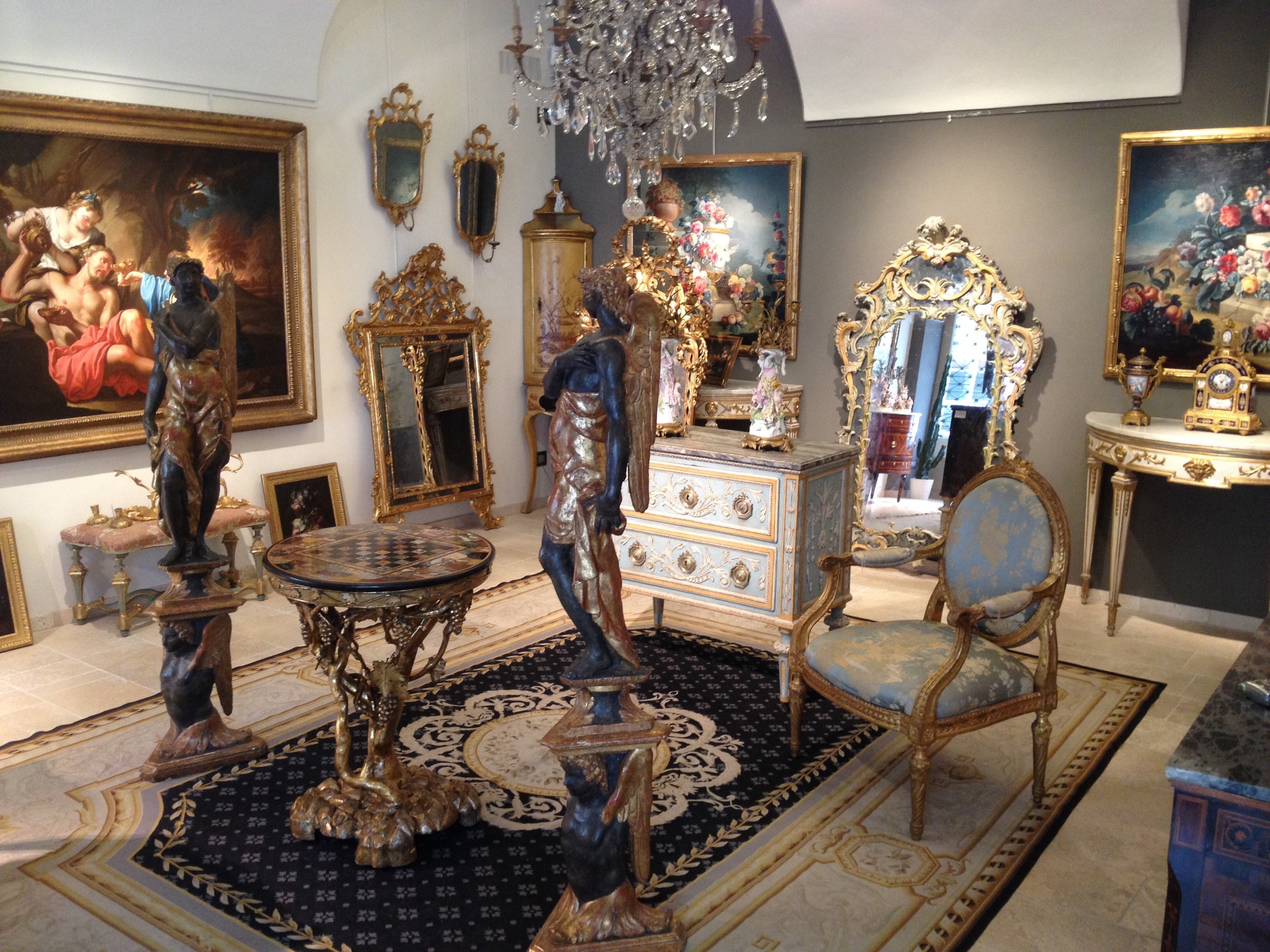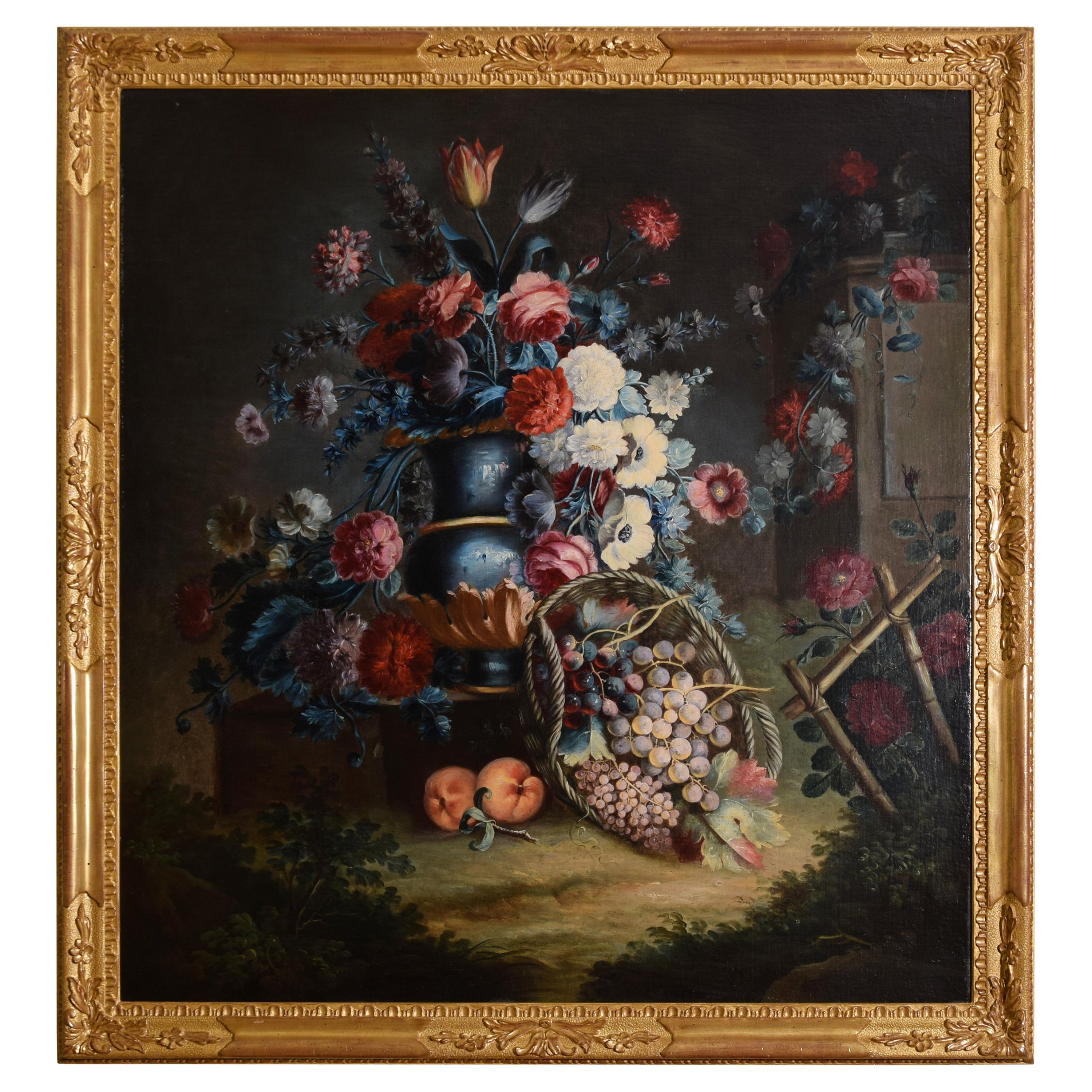Items Similar to 18th Century, Italian painting Depicts Bambocciata by Giovanni Michele Graneri
Want more images or videos?
Request additional images or videos from the seller
1 of 7
18th Century, Italian painting Depicts Bambocciata by Giovanni Michele Graneri
About the Item
Giovanni Michele Graneri (Italy, Turin 1708-1762)
Bambocciata (Farmers dancing in front of the inn)
The painting, made in oil on canvas, depicts a moment of celebration where some peasants or commoners dance and drink in front of an inn.
The style and quality indicate the autograph of a well-known Piedmontese bambocciante: Giovanni Michele Graneri, one of the protagonists of the fruitful Savoy season of this pictorial genre. Graneri was for a time a parallel and then a continuation of the work of the head of the school Pietro Domenico Ollivero, of which, according to contemporary sources, he was a pupil.
The characters depicted, such as the group of dancers in a circle, the old man with the stick, the bassoon player, the drunk farmer sleeping on the barrel and some observers who look out from the doors, windows or balconies, are characteristic of this kind of representation that is called "bambocciata". The bambocciata is a kind of painting aimed at representing, with vivid figurative and animated effects of light and color, popular scenes of the street, taverns, market, gypsies, in open contrast with the great official baroque painting. It spread widely throughout the eighteenth century and in Piedmont, among the greatest exponents are Pietro Domenico Ollivero (Turin, 1679 - 1755) and Giovanni Michele Graneri (Turin, 1708-1762). The concave shape on the lower side of the frame suggests that the canvas was originally placed in a boiserie in the noble rooms of a noble palace.
Giovanni Michele Graneri was born in Turin on 28 September 1708 to a family of modest economic conditions. On 21 August 1747 he married Francesca Margherita Canicoschi from Turin, with whom he had three children and one daughter. He died on 26 February 1762. The first dated works that we know date back only to 1738, and probably his best known work is the large canvas with the Market of Piazza San Carlo of 1752 (Turin, Museo Civico d'Arte Antica), in which stands out a very accurate description of the square, such as to be credited with landscape painting, then repeated in the other large canvas depicting the Herb Square Market (Sarasota, Florida, John and Mable Ringling Museum). The eighteenth-century sources say he was a pupil of Pietro Domenico Ollivero, the most important and famous painter of genre scenes in Turin, and Graneri’s youthful paintings are strongly affected by the influence both in the general layout and in the rendering of the figures. Like Ollivero, Graneri is part of the trend of the painting of bamboccianti that in Turin had been known through the work of both Jan Miel in the mid-seventeenth century and with the paintings of other Flemish painters, such as David Teniers, called the Younger.
The painter denounces de visu knowledge of some prints from copper engravings taken from works by David Teniers, from which he draws many motifs and subjects; however, he draws only a few elements from them. Graneri in fact practices sophisticated readings of other people’s works, presenting personal interpretations. It absorbs from the Teniers, and from Ollivero, certain architectures that have a Nordic inspiration, the setting of the scene, the old beggar with the stick, the subject leaning or asleep to the barrel, the characters dancing, the inevitable dog, a subject that faces the window. Graneri is also concerned to make the real liveliness of the scene with bright colors and funny details, without dwelling too much on the appearance of the figures, which are similar to each other. Unlike Ollivero, the painter does not want to meditate on the human events he describes, but have fun and make ironically the life that flows around him, exasperating sometimes certain aspects until their deformation.
Graneri’s works are distinguished by the wealth of figures with witty looks, genre scenes and characters engaged in everyday life actions that the author returns with freshness and masterful attention. His works testify to the richness and the social variety that was possible to meet in the Turin of the Savoy and are considered valuable artistic documents as well as historical sources of considerable importance.
We apologize for translation errors. Please contact to have the expertise in Italian
- Dimensions:Height: 63.39 in (161 cm)Width: 56.3 in (143 cm)Depth: 1.19 in (3 cm)
- Style:Baroque (Of the Period)
- Materials and Techniques:
- Place of Origin:
- Period:
- Date of Manufacture:Mid-18th Century
- Condition:Refinished. Wear consistent with age and use.
- Seller Location:IT
- Reference Number:1stDibs: LU4405225241202

About the Seller
5.0
Platinum Seller
These expertly vetted sellers are 1stDibs' most experienced sellers and are rated highest by our customers.
Established in 1980
1stDibs seller since 2019
41 sales on 1stDibs
Typical response time: 1 hour
- ShippingRetrieving quote...Ships From: Italy
- Return PolicyA return for this item may be initiated within 7 days of delivery.
More From This SellerView All
- 18th Century Italian Oil on Panel Bambocciata by Jean Miel FollowerLocated in ITJan Miel (follower of) The bambocciante scene Oil on panel , cm 38,5 x 51. frame 66 x 53,5 x 4,5 cm The bright painting, with great chromatic impact thanks to the technique of oil ...Category
Antique 18th Century Italian Rococo Paintings
MaterialsWood
- 18th Century, Italian Still Life by Michele Antonio RaposBy Michele Antonio RaposLocated in ITMichele Antonio Rapos (Turin 1733-1819) Still life with vase of flowers, peaches and a basket of grapes in a garden of roses Already collection Giuseppe Rossi Oil on canvas. Canvas: cm 113,00 x 105,00 – with frame cm H 130,00 x W 121,00 x D 6,00 The canvas, of fine workmanship, belonged to the famous collection of Giuseppe Rossi which was sold at auction by Sotheby’s in 1999. The work depicts a still life with a rich composition of flowers and fruit set in a rose garden. At the center of the canvas a large blue ceramic vase...Category
Antique Late 18th Century Italian Baroque Paintings
MaterialsCanvas
- 18th Century, Italian Still Life with Flowers by Michele Antonio RaposBy Michele Antonio RaposLocated in IT18th century, Italian still life with flowers by Michele Antonio Rapos (Italy 1733-1819) The canvas, of fine workmanship and under good conditions of maintenance, represents a sti...Category
Antique Late 18th Century Italian Baroque Paintings
MaterialsCanvas, Giltwood
- 18th Century, Pair Italian Rococo Still Life Painting by Michele Antonio RapousBy Michele Antonio RaposLocated in ITMichele Antonio Rapos (Turin 1733-1819) Pair of paintings depicting Still Life with fruit composition Oil on canvas, cm H 27 x L 36; frame cm H 37 x L 46 x P 3 The two paintings be...Category
Antique Late 18th Century Italian Rococo Paintings
MaterialsCanvas
- 18th Centuy, Italian Painting with Landscape by Giovanni Battista ColombaLocated in ITGiovanni Battista Innocenzo Colomba (1713 – 1793) Landscape with figures Oil on canvas, Frame H 102 x L 112 x P 8; canvas H 77 x L 87 The valuable painting, attributable to the pai...Category
Antique Mid-18th Century Italian Rococo Paintings
MaterialsCanvas
- 18th Century, Italian Painting Depicting Landscape with Watermill and CharactersLocated in IT18th century, Italian painting depicting landscape with watermill and characters Oil on canvas; Measurements: frame cm L 103.5 x H 127 x P 5; painting L 93 x H 117.5 The painting...Category
Antique Mid-18th Century Italian Rococo Paintings
MaterialsCanvas
You May Also Like
- 18th Century Lying Female Figure Painting by Giovanni Domenico MolinariLocated in Milan, ITGiovanni Domenico Molinari (Caresana, 1721 - Turin, 1793) Lying Female figure Oil on canvas, cm 46 x. 31 - With frame, cm 56 x 42 The present painting is connected by style and treated subject, in this case a young girl lying in an idyllic landscape, to the production of small pictures of pastoral subject of the Piedmontese painter Giovanni Domenico Molinari (Caresana, 1721 - Turin, 1793). Molinare was born in Caresana (Vercelli) on 19 July 1721 but after losing both his parents he moved to Turin. Here he became, from 1736, a pupil of the Academy of Drawing founded by the painter Claudio Francesco Beaumont (Turin, 4 July 1694 - Turin, 21 June 1766) where he remained as a pensioner until December 1755. Molinari was immediately engaged in the translation of the master’s sketches on cardboard used for the Regia manufacture of tapestries. His early success on the Turin art scene is confirmed by the fact that he joined the Compagnia di San Luca in 1756. In 1751 he married Margherita Peiroleri, whose brothers Pietro (engraver) and Nicolò (painter) also attended the school. Remained widower count two other marriages first with Lucrezia Elisabetta Burzio and then in 1770 with Domenica Maria Ferrero. On the death of the master in 1766 Molinari, considered by his contemporaries to be the most faithful interpreter of the master and for his elegant and Arcadian style, which clearly interprets the aesthetic taste of the court, was called to finish the works that remained unfinished, such as the altarpiece for the church of Santa Maria della Scala in Moncalieri depicting the Assumption venerated by Blessed Bernard of Baden and Saint Anthony. Molinari was also well praised by critics and Abbot Lanzi highlighted the quality of the production of historical and mythological subject for the rigorous post-marattesco classicism. In Turin he worked for Vittorio Amedeo III of Savoy as a portrait painter, executing for him eleven canvases (between 1774 and 1775), but, since 1745, he also supplied tapestry cartoons to the local Fabbrica, of which, in 1766, he became director. The production of paintings of sacred subjects is also lively, especially used in the decoration of the churches of the capital as the Assumption for the Hotel of Virtue and San Pietro Regalado and San Benedetto il Moro for Santa Maria degli Angeli ( Torino) He also painted tempera and oil cartoons for the same church, on the occasion of the beatification of Pacifico da San Severino (1787) and, for that of San Francesco di Paola, when Gaspare de Bono...Category
Antique 18th Century Italian Paintings
MaterialsCanvas
- 18th Century Italian PaintingLocated in San Francisco, CACharming old Italian village scene of a young girl with her cow and sheep. Oil on canvas in giltwood frame. The painting without the frame measures 19 3/4" high x 22 3/4" wide. Italy...Category
Antique 18th Century Italian Paintings
MaterialsCanvas
- Early 18th Century painting depicting Adam - Roman SchoolLocated in Firenze, FIBeautiful large oil painting on canvas. The scene depicted is ascribed to the biblical repertoire of the Old Testament, taken from the book of Genesis (Gen 2.18-20) "God assigns Adam...Category
Antique Early 18th Century Italian Paintings
MaterialsCanvas
- 18th century pair of paintings depicting architectural whimsLocated in Firenze, ITLarge tempera paintings on canvas depicting "architectural whims" painted in Venice in 1757 by Alessandro Segalini, set painter. This artistic genre, characterized by the depiction ...Category
Antique 18th Century Paintings
MaterialsPaint
- Painting Lake Garda Italian School 18th CenturyLocated in Lisbon, PTA grand view of an Italian lake, tower with the lake Garda (other name Benaco) and boats in the background. An Italian School from XVIII Century. Frame with glass. Frame: Width: ...Category
Antique 18th Century Italian Baroque Paintings
MaterialsWood, Paper
- Italian 18th Century Oil on Canvas "Madonna and Child" after Giovanni LanfrancoBy Giovanni LanfrancoLocated in Los Angeles, CAA very fine Italian 18th century oil on canvas "Madonna and Child" after Giovanni Lanfranco (Italian, 1582-1647). The young Virgin Mary attending to...Category
Antique 18th Century Italian Baroque Paintings
MaterialsCanvas, Giltwood
Recently Viewed
View AllMore Ways To Browse
18th Century Baroque Painting
Italian Baroque Painting
Chest With Painting
Over Door Decorations
Painting Antique Windows
Italian Baroque Canvas
Used Balcony Furniture
Barrel 18th Century
Antique Kitchen Chest Of Drawers
Mid Century Modern Painted Chest
The Antique Inn
Antique Gypsy
Gypsy Antique
Antique Gypsies
Antique Balconies
Antique Balcony
Wall Console With Drawers
Black Color Modern Chests





